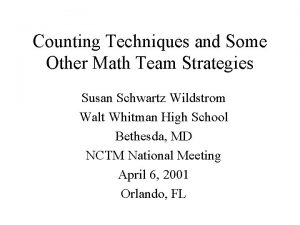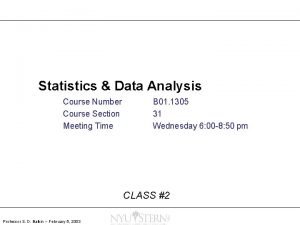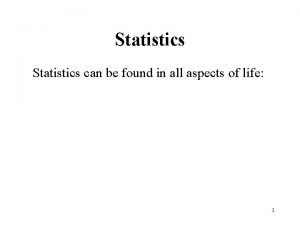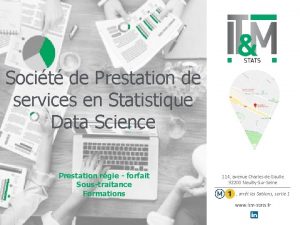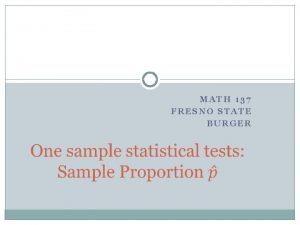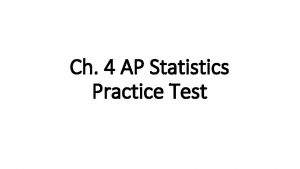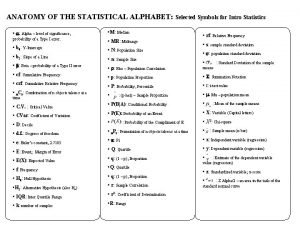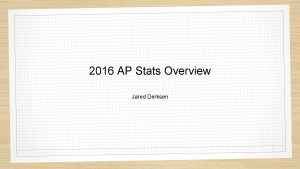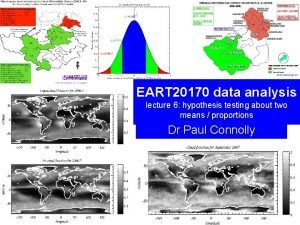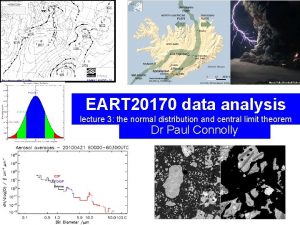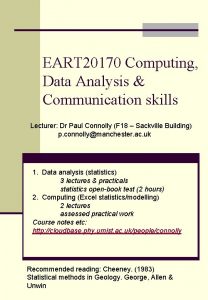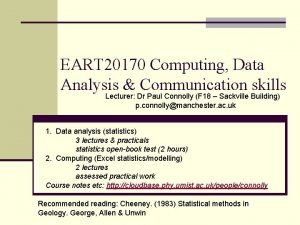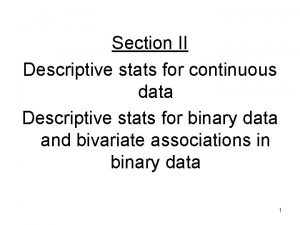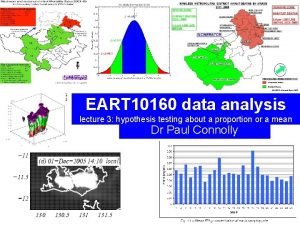EART 20170 data analysis lecture 2 descriptive stats
























- Slides: 24

EART 20170 data analysis lecture 2: descriptive stats and outliers Dr Paul Connolly

Frequency tables and histograms • A frequency histogram is a plot of binned data using the bin mid-points and the frequency in the bin as x and y values respectively. • Excel doesn’t do this by default… – It uses upper bin edges. – So bin upper edges need to be shifted before plotted • Why is Excel is a pain!

Overview this week • Descriptive statistics (4 boring slides, sorry!): – Mean, Median, Mode – Standard deviation, variance, standard error, range. • Outliers: – Spotting them in histograms – Definition using `z-score’ • Rare values: – Determined using `z-score’ • Visual comparison of histograms

Definition: Mean, page 8 notes xi= values in a list S- means to sum all values N = number of data points in a list (sample size). Excel: =AVERAGE(A 1: A 10) (see table page 45 of notes) MATLAB: mean(dat) (see table page 45 of notes)

Definition: Median and Mode • Median: half way point in a ranked list of numbers. – Excel: `=median(A 1: A 10)’ (see table page 45 of notes) – MATLAB: `median(dat)’ (see table page 45 of notes) • Mode: most frequent value (the highest point in a histogram) – Excel: `=mode(A 1: A 10)’ (see table page 45 of notes) – MATLAB: `mode(dat)’ (see table page 45 of notes)

Definition: Standard deviation, page 9 notes xi= values in a list S- means to sum all values N = number of data points in a list. Normally: 68. 3% of data lies within 1 standard deviation of the mean 95. 5% of data lies within 2 “ 99. 9% of data lies within 3 “ Excel `=STDEV(A 1: A 10)’ (see table page 45 of notes) MATLAB `std(dat)’ (see table page 45 of notes)

Definition: z-score If you don’t know the population mean, , just use the sample mean. This tells us how many standard deviations away from the mean a value is. Remember that normally: 68. 3% of data lies within 1 standard deviation of the mean 95. 5% of data lies within 2 “ 99. 9% of data lies within 3 “

Old faithful geyser: determining outliers

See OLDFAITH. xls

See OLDFAITH. xls Duration of eruption

• Frequency density: – Frequency divided by the sum of the total, divided by the bin width – Area under the curve=1 What value is 90% of the data less than (or 10% of the data larger than)? • Cumulative Frequency: – Cumulative sum of frequency histogram (from the left) divided by the total. – Max value of curve=1

Page 29 says The wording is atrocious! (and probably purposely written so that lay people do not understand it. ) In other words, just produce a cumulative frequency plot and find the sound level corresponding to cumulative frequency=0. 9

How can we tell whether the duration of eruptions of old faithful is changing or unusual? How do we quantitatively say that these are unusual? • The histogram is asymmetric • Visually, they are separated from the main `mode’ • Could also calculate the z-score for the list of data.

Rare values are not the same as outliers, but statistically can be determined in a similar way (e. g. calculating the z-score)…

Geophysics: gravity anomalies • Gravity: more mass = higher attraction. • BGS measure the observed gravity in units of m. Gal (1 x 10 -5 m s-2) • Tell you about the geology of the UK.

Histogram of observed gravity over the UK Positively skewed i. e. every so often it is higher than most of the values • The positive skew makes observed gravity difficult to analyse statistically.

Geophysics: the Bouguer anomaly • Difference between expected value of gravity and actual. – +ve anomaly means there is less gravity than expected – and vice-versa. • Tells you about how dense the underlying surface is. • i. e. if there is a large oil field or meteorite below the surface.

It turns out that distribution Bouguer anomaly over the UK almost symmetrical. It is normally distributed this makes it much easier to analyse in the context of this course (next practical). There are no obvious outliers in the histogram. Although there are no obvious outliers you will be asked whether a value is unusual. In this context we are asking whether a value is rare

Comparing histograms to say whether datasets are similar (or not)

Do brand-name biscuits have more chocolate chips than the supermarkets brand?

Your population data might look like: Number of biscuits Store brand Name brand e h t t a h t ? s y p i a s h c u o e r y o n m s Ca a h d n a r b e m ? a u n o y e r a n i a t r e c w Ho Number of chocolate chips per biscuit

• Either do in Excel or MATLAB (help will be on hand) • You. Tube tutorials • Spreadsheets and data.

• MATLABers, if you want to learn how to plot out the landgrav data from BGS see second page • `scatter’ function deals with ungridded 2 -d spatial data • We will also learn how to deal with gridded data. • I would not know how to do this in Excel.

Week 4 practical • You are given several datasets and asked to say whether different values are usual or un-usual. – Use the z-score to say how many standard deviations from the mean the values are. Larger than 2 standard deviations are un-usual. • You are asked to look at a cumulative frequency distribution and comment on it. • You are asked to create several histograms – practice, practice. • You are asked to compare different histograms of VOLTAGES to say whether different datasets are different. – Look to see how much of the histograms over-lap with each other and how different the modes, and variations are.
 Spacegoo com maze
Spacegoo com maze Eart cuff
Eart cuff Meteo eart
Meteo eart Eart
Eart Googol eart
Googol eart Fæder ure þu þe eart on heofonum
Fæder ure þu þe eart on heofonum What is erosion
What is erosion Thy thou thee old english
Thy thou thee old english How to plot
How to plot 01:640:244 lecture notes - lecture 15: plat, idah, farad
01:640:244 lecture notes - lecture 15: plat, idah, farad Exploratory data analysis lecture notes
Exploratory data analysis lecture notes Statistics complement rule
Statistics complement rule What is statistics
What is statistics Privisol
Privisol It&m stats
It&m stats Contrast and contradictions nonfiction examples
Contrast and contradictions nonfiction examples Stats p hat
Stats p hat Modality in statistics
Modality in statistics Chapter 24 paired samples and blocks
Chapter 24 paired samples and blocks Ap stats practice test multiple choice
Ap stats practice test multiple choice Ap stats chapter 7 review
Ap stats chapter 7 review Statistics symbols
Statistics symbols Mrs daniel ap stats
Mrs daniel ap stats Ap stats frq 2016
Ap stats frq 2016 Stats refund
Stats refund




